CANADA
Ottawa

Ottawa
Ottawa
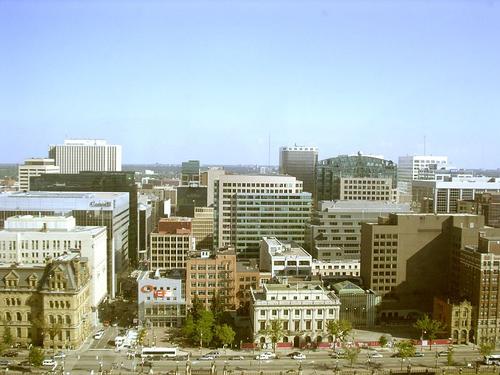 Down Town OttawaPhoto: Public Domain
Down Town OttawaPhoto: Public Domain
Ottawa is the capital of Canada and the fourth largest city in the country. The city is located in the eastern part of Southern Ontario on the southern bank of the Ottawa River. Ottawa and the neighboring cities of Gatineau and Quebec form the National Capital Region (NCR). The city was founded in 1826 as Bytown and was named Ottawa in 1855. The city quickly developed into Canada's political and technological center. Ottawa expanded its territory and the population grew, but the big expansion occurred in 2001, when the land area increased significantly due to a merger. The name Ottawa is derived from the Algonquin word adawe, which means "the trade". Since its very beginnings as an Irish and later French settlement, Ottawa has developed into a multicultural city with diverse populations. According to the 2011 census, the city had a population of 883,391 inhabitants, the metropolitan area had a population of 1,236,324 inhabitants, and the National Capital Region had 1,451,415 inhabitants.
Location
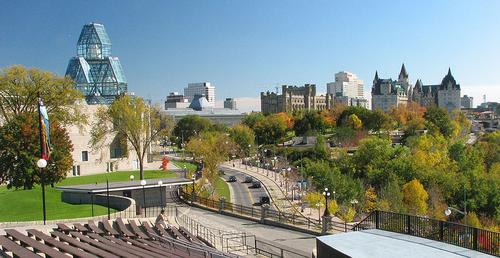 OttawaPhoto: Public Domain
OttawaPhoto: Public Domain
The coordinates of Ottawa are: 45°25'15' North latitude and 75°41'24' West longitude. Ottawa is located on the south bank of the Ottawa River, which originates from the confluence of the Rideau River and the Rideau Canal. The old part of the city is known as the lower town and lies between the canal and the river. Remains of old Bytown can still be seen. Ottawa's financial and commercial center extends west across the channel. The 202-kilometer long Rideau Canal runs to Kingston and Fort Henry and was declared a UNESCO World Heritage Site on June 29, 2007.
Weather
Ottawa has a humid continental climate with four different seasons. The average maximum temperature is 26.5 °C in July. The average minimum temperature is -15.3 °C in January. Summers are warm and humid. During the day the temperature often rises to 30 °C or even higher. Snow and ice are dominant during the winter season. Ottawa has 235 inches of snowfall on average per year. The nights are particularly cold in winter, often with temperatures below -20 °C. Daytime temperatures are not as low. Spring and fall are variable, with frequent extreme temperatures and unpredictable weather conditions. The sun shines an average of 2060 hours per year.
 Rideau Canal Ottawa in winterPhoto: Public domain
Rideau Canal Ottawa in winterPhoto: Public domain
History
The first Europeans arrived on the site of the current city in 1610. The tribe of the Algonquin Indians previously lived on the banks of the Ottawa River for centuries. In 1613 Samuel de Champlain wrote about the falls and about his encounters with the Indians. These early explorers were later followed by many missionaries. The first settlement in the area was established on March 7, 1800 on the north side of the river.
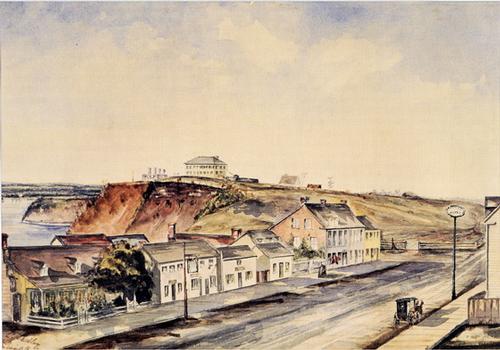 Blytown Montreal in 1853Photo: Public Domain
Blytown Montreal in 1853Photo: Public Domain
Bytown was founded in 1826 and construction of the Rideau Canal was started. The timber trade in the valley developed into the most important economic branch in the area. Wood was transported downstream through the Ottawa Valley to Quebec.
On December 31, 1857, Ottawa was elected capital of what was then still known as the Province of Canada. Large sawmills were built in the second half of the 19th century. The National Capital Region experienced a major economic upswing with many construction activities from the 1960s to the 1980s. In the later decades, a high growth of the high-tech industry followed. In 2001, the twelve existing municipalities merged to form the current city of Ottawa.
Ottawa Sights
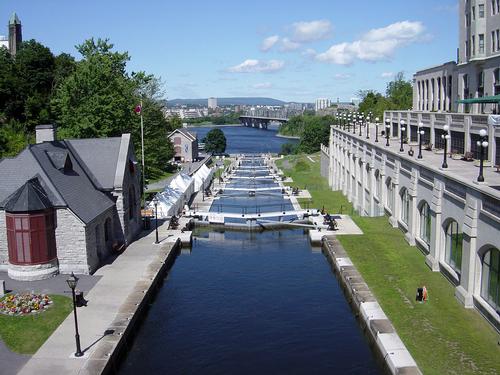 Rideau Canal in Ottawa Photo: Bobak Ha'Eri CC 2.5 Generic no changes made
Rideau Canal in Ottawa Photo: Bobak Ha'Eri CC 2.5 Generic no changes made
One of the city's oldest attractions is the Rideau Canal, North America's oldest continuously operated canal system. It was declared a UNESCO World Heritage Site in 2007. There are twenty four National Historic Sites in and around Ottawa.
Ottawa Parliament BuildingPhoto: Jeffery Nichols CC 3.0 Unported no changes made
Parliament Hill is the center of politics in Canada, it is made up of a number of important and historic buildings and is home to the House of Commons, members of Parliament and the Senate. You have a beautiful view of the river from here. The parliament building is built in a Gothic architectural style. The Peace Tower is high above the parliament buildings. The Peace Tower is approximately 92 meters high and consists of more than 50,000 stones, with a huge clock measuring almost 4.8 meters in diameter.
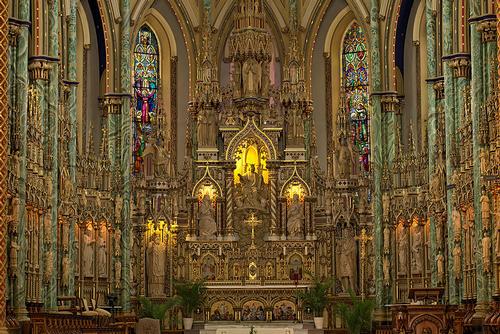 Altar of Notre Dame Basilica in Ottawa Photo: Sergiu Dumitriu CC 3.0 Unported no changes made
Altar of Notre Dame Basilica in Ottawa Photo: Sergiu Dumitriu CC 3.0 Unported no changes made
Notre Dame Basilica is an imposing building, with striking Neo-Gothic architecture and many historical elements. Dating back to the mid-19th century, the church is the city's oldest church and one of the major landmarks in Ottawa. The church has two towers and a beautiful interior, other highlights of the cathedral are the colorful stained glass windows and beautiful stone statues.
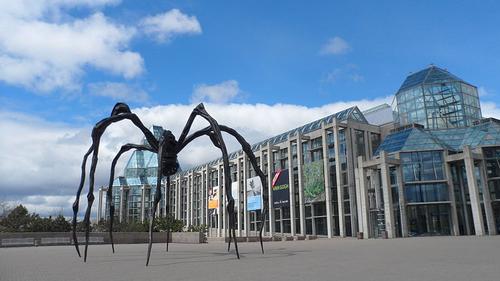 National Gallery of Canada in OttawaPhoto: Tullia CC 3.0 Unported no changes made
National Gallery of Canada in OttawaPhoto: Tullia CC 3.0 Unported no changes made
One of the city's finest museums, the National Gallery of Canada is housed in an impressive building built in the late 1980s. The National Gallery is located in the central part of Ottawa and contains extensive collections of paintings and sculptures, including works by renowned artists such as Cézanne, Chagall, Constable, Matisse, Monet, Picasso, Pissarro, Rembrandt, Rodin, Rubens, Van Gogh and Warhol.
The Canadian War Museum features a wealth of war-related artifacts and military memorabilia. Also of interest are the extensive research facilities and large historical collections of the Museum.
The Canadian Museum of Nature was built in 1905 and it was completely renovated between 2004 and 2010. The city also houses the Canada Aviation and Space Museum and the Canada Science and Technology Museum.
The National Arts Center was opened in 1969 as a major venue for the performing arts. The National Arts Center Orchestra, the Ottawa Symphony Orchestra and the Opera Lyra Ottawa play here.
Tips
Ottawa's cultural life takes place in Lower Town, Downtown and Parliament Hill. The streets around Wellington Street, Rideau Street, Sussex Drive, Elgin Street, Bank Street, Somerset Street, Preston Street and Sparks Street are the places with many boutiques, museums, theaters, galleries, restaurants, cafes, bars and night clubs.
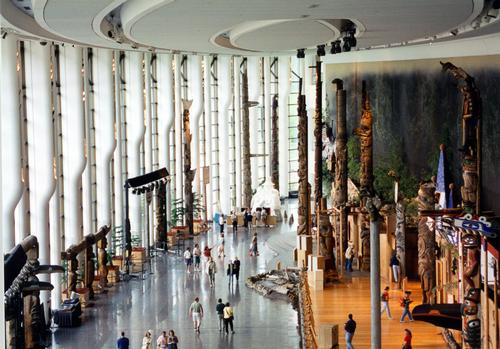 Entrance hall Canadian Museum of CivilizationPhoto: Wojciech Dittwald CCe 3.0 Unported no changes made
Entrance hall Canadian Museum of CivilizationPhoto: Wojciech Dittwald CCe 3.0 Unported no changes made
Located across the Ottawa River in Gatineau, the Canadian Museum of Civilization is the most visited museum in Canada. The museum is located a few miles outside of Ottawa in the Hull area. Highlights at the Canadian Museum of Civilization include exhibits on archeology, arts and crafts, cultures, military history, indigenous civilizations in Canada, and even a special collection of totem poles. The museum also features an IMAX theater, the Canadian Postal Museum and the Canadian Children's Museum.
Useful links Ottawa
BBC Country ProfilesWorld Fact Book Explore all Countries
How to call
Last updated November 2025
Copyright: Team - The World of Info